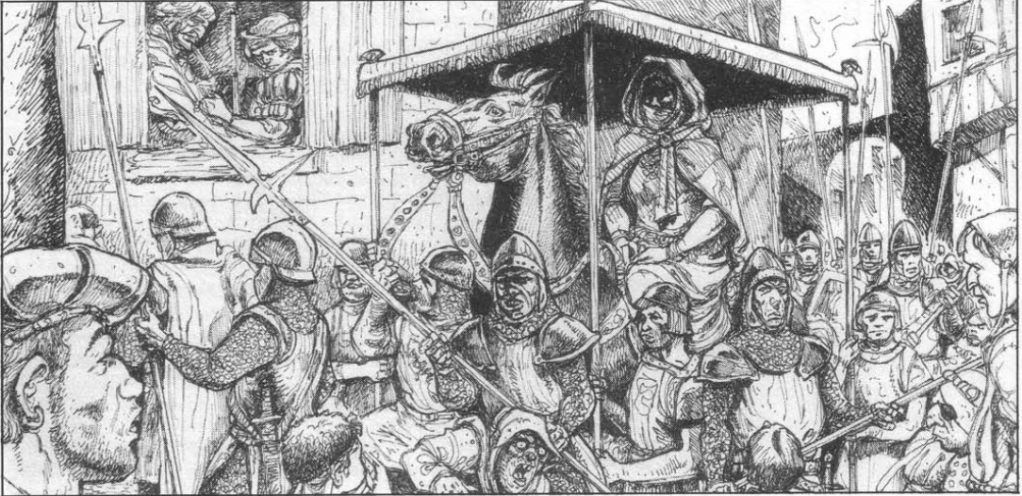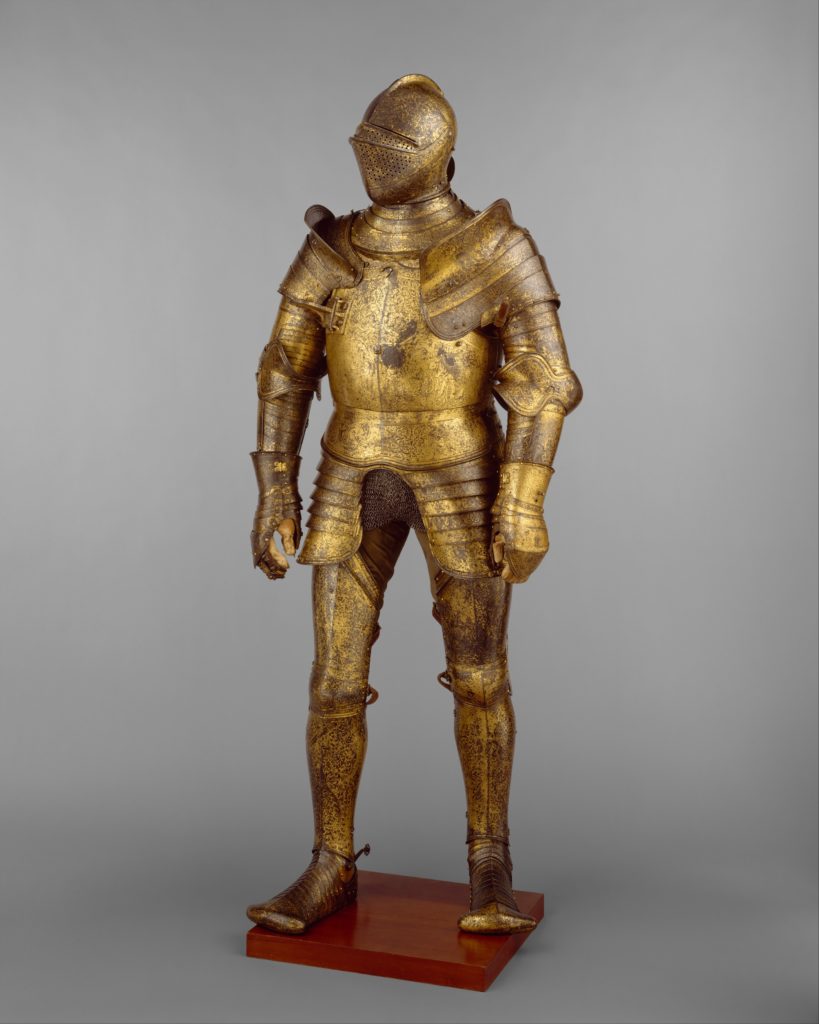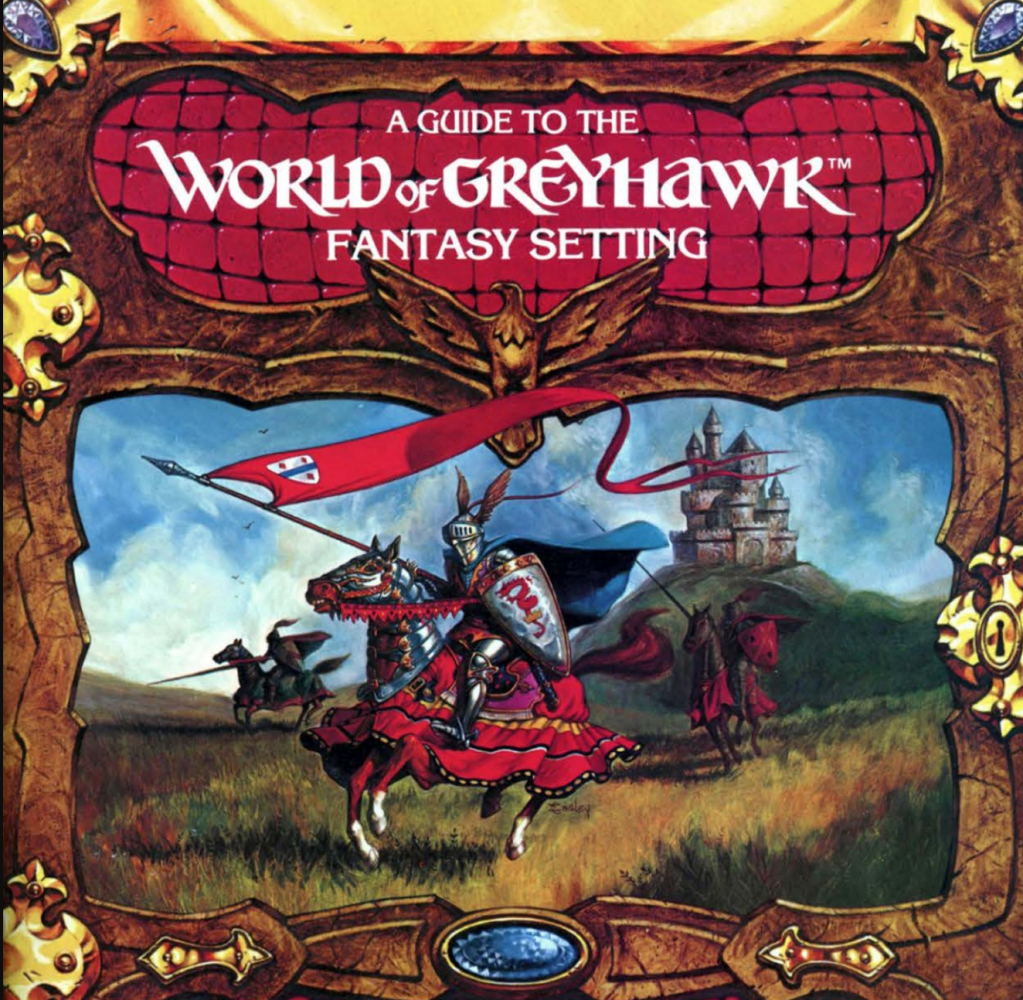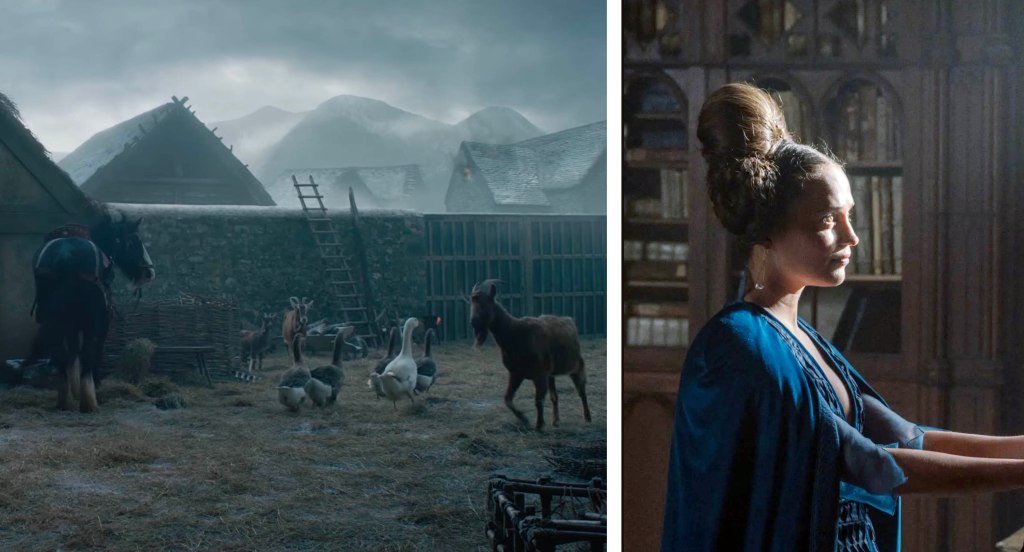Pre-Raphaelite Arthur, part 1: Arabian Nights, Authenticity and the Arche
Over the summer I saw an exhibition of Pre-Raphaelite Arthurian artworks, which included a couple of tapestries, now owned by Jimmy Page of Led Zeppelin fame – he who took his copy of Lord of the Rings to the Glastonbury festival and (along with Moorcock) pretty much kicked off the liaison between metal and fantasy.
So I think there’s some interesting things to say about the content of Pre-Raphaelite Arthurianism but before I get there I have to clear my throat over the genealogy of Arthurian myth in popular entertainment and roleplaying circles – Arthur’s Appendix N, if you like – and why we seem to favour different ingredients of that genealogy at different times. So if you’re up for an extended musing on the history of Arthurian and British medieval representation, strap in.
While Gygax was percolating the ideas that would eventually become D&D, US popular entertainment was telling a particular set of stories about Merrie Oldee Englandeee, with Poul Anderson’s Three Hearts and Three Lions, Gilbertson’s Ivanhoe comics,
…and Disney’s 1950s anglo-historico-romance films: The Story of Robin Hood and his Merrie Men, The Sword and the Rose, and Rob Roy.
Together, those stories form a particular view of medieval Britain that draws heavily on the 1810s to 1830s works of that inveterate romantic nationalist Sir Walter Scott, the inventor of Ivanhoe, romanticizer of Rob Roy, and inspirer of, among others, the Pre-Raphaelites and Alfred, Lord Tennyson, who wrote a whole bunch of Arthurian epic poems for them to illustrate. To get a taste of Scott’s style and how his thought was shaped by Arthurian romances, you can look at his articles in the 1824 Encyclopedia Britannica, on Chivalry, Romance, and Drama:
“In every age and country valour is held in esteem, and the more rude the period and the place, the greater respect is paid to boldness of enterprise and success in battle. But it was peculiar to the institution of Chivalry, to blend military valour with the strongest passions which actuate the human mind, the feelings of devotion and those of love.”
As for the fair maidens who excited those manly passions, they had better be chaste and pure, because “wherever women have been considered as the early, willing, and accommodating slaves of the voluptuousness of the other sex, their character has become degraded… On the other hand, the men, easily and early sated with indulgences, which soon lose their poignancy when the senses only are interested, become first indifferent, then harsh and brutal to the unfortunate slaves of their pleasures. The sated lover,—and perhaps it is the most brutal part of humanity,—is soon converted into the capricious tyrant, like the successful seducer of the modern poet.”
So you can see how 50s Hollywood might have liked Scott. His rants against “the Romish clergy, who have in all ages possessed the wisdom of serpents” are a digression I guess I don’t need to go into now. On the other hand his frequent asides on “the love of our country and its liberties” played just as well in Joe McCarthy’s day as in George W. Bush’s.
So here’s a funny thing about encountering D&D’s version of the medieval in Britain in the 1980s: that heroic Scott/Tennyson strand was deeply out of favour. Especially in its Hollywood incarnation, with shiny armour and technicolor yeomen, it provoked an emetic reaction. I don’t know exactly why Britain went all in on the Dung Ages after WW2 (although I can hazard a few guesses, based on postwar austerity and disillusionment, changing class relations, the collapse of the Empire and Britain’s prestige, etc.). I also don’t know why Tolkien seems to have been exempt from it (C S Lewis’s Narnia was less exempt: wearing its Christian and Arthurian allegory on its sleeve, it was dismissed as children’s lit). But I do know that talk of shit-covered peasants wasn’t limited to Monty Python – Holy Grail satirized a popular discourse which had obviously gone too far, but which would continue to be repeated right through the 1990s.

WFRP, obviously, encapsulates the RPG end of this mood about Britain’s past and character, but it doesn’t exhaust it: in the 70s and 80s my schooling emphasized the filth, disease, and short life expectancy of the medieval era as the bottom of a hole we had recently climbed out of. As for King Arthur, if there was any real historicity to him (and my primary school teacher was convinced there was), he was probably a Romano-British hill chieftain fighting off the Saxon invasion at the dawn of Britain’s Dark Ages – more a pitiable Alfred burning the cakes than any majestic flower of chivalry or guardian of England’s destiny.

(Aside: David Lowery’s recent Green Knight plays interestingly with Dung Ages tropes – the start of the film sees young Gawain sleeping off a hangover in a barn while the house across the muddy yard is burning. Arthur’s court is as threadbare and caveman-stark as any Trevor Nunn staging. But then Lord Generous’s tempting castle occupies a comfy Elizabethan early modernity – deviating from dung is where Gawain goes wrong, being a Son of the Soil after all)
So the Arthur I grew up with was part Monty Python, part dirt-poor resistance fighter – provided he was suitably dirty and down-at-heel. But if there was any whiff of the knight in shining armour cliche, that belonged to a discredited strand of romantic fantasies more akin to Mills&Boon bodice-rippers.
I knew there were stories behind that shiny romantic tradition (and there was Greg Stafford’s Pendragon, if you could get anyone to play it) and I knew there were images that went with those stories but… you had to kind of willfully ignore them, like in The City and The City. They were not serious or realistic or authentic (words actually used sincerely (by me!) in the 80s/90s regarding FRP rule systems).
As a result, my conception of what was properly medieval was resolutely unheroic and anti-Arthurian and I wouldn’t look seriously at the 19th century construction of Arthur for decades. It wasn’t right, it wasn’t “canonical,” it wasn’t worth bothering with: if there was any way for me to rediscover Arthur it would be by looking straight past the romantic knight tropes and past Malory’s high romantic 14th century vision (still too shiny) and trying to squint it out of Geoffrey of Monmouth and the Mabinogion.
Which was stupid of me, first because Geoffrey of Monmouth is the Dave Hargrave of the 12th century, a reliable guide only to his own inventions (at best), and second because whether I ignored it or not, the 19th century work remains instrumental in forming the frame we all look through when we look back at the romances of Malory and Chretien de Troyes. Because, let’s face it, the 19th century always sits in between whatever came before and our view of it.

So I was already thinking about ideas of authenticity and historicity when I started listening to a reading of the Arabian Nights – specifically the collection edited by Muhsin Mahdi, which claims to be “the definitive Arabic edition… the oldest surviving version of the tales and considered to be the most authentic.” And it’s an interesting comparative case.
First, the 14th century Syrian manuscript Mahdi’s collection is drawn from is not the only claimant to antiquity – its reputation rests partly on its similarity to other old manuscripts. The editor notes “no one knows exactly when a given story originated, and many circulated orally for centuries before being written down,” which makes the whole question of what’s definitive hard to even discuss. But this apparent weakness in supporting the definitive claim turns out to be a secret strength for the stories’ authentic claim: “in the process of telling and retelling, they were modified to reflect the general life and customs of the Arab society that adapted them” so that the 14th century manuscript shows “a distinctive synthesis that marks the cultural and artistic history of Islam.”
Well. Maybe. I don’t know how you would prove that and I’m wary of claims to read the soul of the past, whenever they show up. In any event, choosing to cut this synthesis off at the 14th century is an editorial power move: it sorts stories into real (14th century) Islamic culture and… not. Which is how connoisseurship always works – carving out a subject on which one can become an authority. It is intensely annoying for a collector that there should be a diverse oral tradition that they can never fully capture and master. Different collectors hold up competing “original editions,” and then publishers want to cut through the confusion, claim the high ground and put out a “proper, authoritative” version, and then inevitably someone out there literally collects 1001 stories and…
And it’s a matter of interpretation and selection because, as the translator notes, the Syrian manuscript only represents one tradition of Arabian Nights storytelling. Some time after the manuscript was made, a vibrant print culture in Egypt and Europe distributed a load of reprints and rewrites, adding tales (including, notably, The Seven Voyages of Sinbad) and generally destroying the idea of a single common core of stories. Much of this print culture happened in French, which is the first language of several early editions of these “Egyptian” stories. The editor’s decision to exclude all of these and his dismissal of Aladdin and Ali Baba as forgeries (since they were written in Paris in the 18th century, maybe by an Arabic-speaking Syrian Christian migrant, and entered the corpus initially in French translation) establishes a fence between the Collectible Authentic Object and a yawning, inclusive chaos. If you let Parisian Aladdin in, do you have to include Disney’s Aladdin movies? So the omission of Sinbad and Aladdin, perversely, guarantees the authenticity claim because why would you leave the best-known pieces out unless you had a good reason?
Muhsin Mahdi has his reasons. But it’s up to you, really, where you draw your boundaries.
With the tales of Arthur and his knights, and with their place in defining the image of a medieval world, it seems to me that insisting on consulting only authentically medieval sources doesn’t do away with the problems of what to include – ignoring Malory is silly, because he’s already done much of the work of reading old Welsh for you. The Malory and Chretien de Troyes collections are famous and long-standing but not sufficient: there’s also the whole Matter of Britain still hanging out there, only partly available to non-specialists and tailing off into Welsh and Breton myths. If on the other hand we treat Arthuriana as a living tradition and draw a wide, inclusive boundary like we would with the “Egyptian” Arabian Nights, we wind up enclosing so many contradictory creations that we lose all coherence – it becomes impossible to say what isn’t Arthurian. Which is a real problem for a medium of collaborative storytelling like RPGs, where the important thing is to generate a common understanding – some stable platform that allows you to judge which actions are genre-appropriate and what does and doesn’t fit – what constitutes a knight, a quest, and a dragon, and why those elements matter.
So let’s imagine for the sake of argument we’re after a more limited, authenticky sort of specifically British Arthur and we arbitrarily discount anything from the advent of Hollywood, since that tends to change everything to fit its own shape. Before we even get around to worrying about which side of the pale Scott, Tennyson and the Pre-Raphaelites fall on, we have to deal with Henry Tudor’s propaganda version from the late 15th century, composed just a few decades after Malory’s death. In this telling, Henry VII, as unifier of England after the Wars of the Roses, is the returned Once and Future King. He commissions a Round Table for his eldest son, Arthur (yes actually) to rule from.
Nothing Arthurian ever goes according to plan, of course, so Arthur dies in childhood, leaving his brother Henry VIII to resurrect that Round Table idea, by repainting a giant antique table he found, to present himself as King Arthur reborn.

In fact, if there was ever a real, historical person who looked and acted like a romantic, literary Arthurian knight, it’s the young Henry VIII. He loved to joust – he even set up perhaps the greatest of all tourneys to challenge the French king and knights in 1520, which makes it about the same length of time after Malory’s le Morte D’Arthur as the Lord of the Rings movies came after the book.

And he had several lovely sets of full jousting plate armour – bullet-proof and everything – made in his own Royal Armoury at Greenwich.

And he was just about the right level of deadly and doomed when it came to the women in his life, although maybe popular history hasn’t quite pieced together that jigsaw puzzle of misogyny disguised as veneration, yet. His only real flaws as an Arthurian archetype are that he got old and fat (more villainous King Mark than forever-fighting romantic lead) and that he was born too late: the 16th century isn’t quite the right period for a character whose primary chronicler died half a century before – if we still believe at all in a “right period” for Arthur.
All of the Tudors were schooled in propaganda, so it shouldn’t surprise us that during the reign of Elizabeth I, Arthur (or possibly his relative Prince Madoc) was deployed once again as the secret original conqueror of America. “The case could be made therefore that, as a descendant of Arthur and through Madoc, Elizabeth had rights to North America” – and the hated Spaniards were merely squatting on English soil.
Oddly enough, that’s not the Arthurian legend Hollywood chooses to remember. But I can’t say I blame them – the popular consensus though history has been, if you want an authentic Arthur, you have to create one yourself. Which brings us back to the Pre-Raphaelites (in the next instalment).
“O purblind race of miserable men,
How many among us at this very hour
Do forge a life-long trouble for ourselves,
By taking true for false, or false for true;
Here, thro’ the feeble twilight of this world
Groping, how many, until we pass and reach
That other, where we see as we are seen.”
Tennyson: Geraint & Enid





What do you make of Boorman’s Excalibur, which manages to be both Mud and Peasants *and* Shiny Knights, at the same time, somehow without contradiction?
I only just watched Excalibur for the first time yesterday and I have thoughts! Especially that one, in fact, that the knights are the One Shiny Thing in a dirty world. It’s absolutely intentional, of course. But one of the most striking things is that initially everyone’s armour is black – it’s only Lancelot who appears in gleaming white metal. But the very next scene after his intro fight is Arthur’s wedding, and _then_ all the knights go shiny. So I think it’s actually supposed to be, like, the shine of divine favour? Like the green reflections in the sword is the reflection of The Dragon.
Thinking more about what mud signifies in Excalibur, it’s really only evident outside the blessed kingdom era of Arthur’s reign, isn’t it? Young Arthur, when he’s winning over the nights, has to bathe in moat water and get dirty climbing pathetic ladders. But then he meets Lancelot, gets married… and then there’s no more dung ages until the king and kingdom are sickened, after the separation from Lancelot and the disappearance of Merlin. That’s when we get the begging peasants scenes. The knights’ desperation on the grail quest is also written on their armour – it’s only after the grail restores Arthur that he puts shiny plate back on.